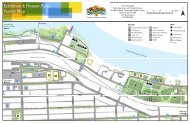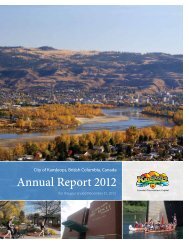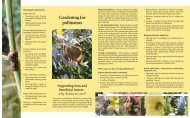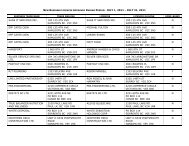Planting the seeds for a sustainable future - City of Kamloops
Planting the seeds for a sustainable future - City of Kamloops
Planting the seeds for a sustainable future - City of Kamloops
You also want an ePaper? Increase the reach of your titles
YUMPU automatically turns print PDFs into web optimized ePapers that Google loves.
At one time, <strong>the</strong>re were 16 dairies operating in <strong>Kamloops</strong>. A processing plant was built in 1946 to support <strong>the</strong>se farms butclosed in <strong>the</strong> early 1950s which put many local dairy farms out <strong>of</strong> business. Today only one dairy farm (Blackwell Dairy Farm)operates in <strong>Kamloops</strong>.By <strong>the</strong> 1950s, consolidation <strong>of</strong> smaller companies and a year <strong>of</strong> severe wea<strong>the</strong>r resulted in a decline in <strong>the</strong> local growingindustry. Improved highway networks resulted in a heightened reliance on imported produce due to cost savings. Pressures<strong>for</strong> apple and tomato growers to subdivide <strong>the</strong>ir land <strong>for</strong> housing increases as many <strong>of</strong> <strong>the</strong> BC Fruitlands' apple trees(Brocklehurst) were killed by early frost. A lack <strong>of</strong> sufficient farm and ranch labour and <strong>the</strong> cost <strong>of</strong> labour began to affect <strong>the</strong>local sector and added to production costs.By <strong>the</strong> early 1970s, <strong>the</strong> overall acreage <strong>for</strong> commercial vegetables in <strong>Kamloops</strong> had dropped substantially. The ALR, aprovincial zone that still exists today to protect and preserve agricultural land and control non-agricultural uses on farmland,was established through a public hearing process <strong>of</strong> <strong>the</strong> provincial government.Today, few <strong>of</strong> <strong>the</strong> local agricultural support organizations <strong>of</strong> <strong>the</strong> past still exist, and most <strong>of</strong> <strong>the</strong> food purchased locally isimported from <strong>the</strong> United States, Mexico, and beyond. Many local growers and ranchers still face challenges related toirrigation, farm labour, and pressure to subdivide <strong>for</strong> housing.A detailed description <strong>of</strong> <strong>the</strong> issues and challenges faced by producers today can be found in <strong>the</strong> Issues Summary Section <strong>of</strong>this report.Lessons Learned From History:<strong>Kamloops</strong> produced more <strong>of</strong> its own food per capita in <strong>the</strong> past than it does now;There was considerable infrastructure in place <strong>for</strong> storage and processing <strong>of</strong> local food as well as industrysupport systems;The <strong>for</strong>mer KXA was an important part <strong>of</strong> <strong>the</strong> local/regional agricultural fabric that brought in people anddollars associated with <strong>the</strong> bull sale, winter fair, pro rodeo, horse racing and o<strong>the</strong>r activities. A lack <strong>of</strong>support and awareness <strong>of</strong> <strong>the</strong> value <strong>of</strong> <strong>the</strong> KXA and what it stood <strong>for</strong> might be contributing factors to itsdeparture;Ranching has survived historically because <strong>the</strong> local resource base is well-suited <strong>for</strong> this purpose. It cancoexist in areas also used <strong>for</strong> o<strong>the</strong>r purposes such as logging, recreation, and wildlife habitat; and,A higher cost <strong>of</strong> living and <strong>the</strong> availability <strong>of</strong> mass-produced, cheap, imported food has resulted in fewerhouseholds supporting local producers as <strong>the</strong>ir products tend to cost more.CITY OF KAMLOOPS 14
















